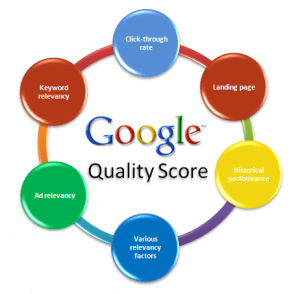Adwords are surprisingly complicated – a side effect of having LOTS of user options and the TON of data google collects and crunches to optimize user experience (ie, the likelihood of internet searchers to quickly find relevant ads).
Infographic by pulpmedia: Awesomely Accessible Lesson in the Basics of Adwords
1) What you pay (CostPerClick) depends on:
* [how much you bid]
* [Quality Score of your ad] – this itself is way complicated – see below
* [Adrank of advertiser in lower rank position]
2) Two Tactics to optimize your Adwords:
2.1) Test Your Ad Copy:
2.1.1) Always have at least 2 ad variations; eg, “Blue Shoes for Sale” and “For Sale: Blue Shoes”. Google will test out your ads’ performance and help you use the higher performing ad copy, so you want at least 2 at a time for testing purposes.
2.1.2) Analyze the data. Pulpmedia suggests experimenting with different metrics: One ad might have slightly higher CTR (click through rate) but significantly lower CVR (conversion rate).
2.2) 3 Easy Bidding Strategies:
2.2.1) Pause Keywords for 30 days when Impressions > 200 and CTR < 1%
2.2.2) Pause Text Ads for 30 dyas when Impressions > 200 and CTR < 1%
2.2.3) Raise max CPC to first page bid estimate for 30 days when Average Position > 1.8 and Quality Factor < 4.
Infographic by Pulpmedia Online Marketing
Quality Scores: Not Simple
There simply isn’t a way to dumb-down Quality Scores: they comprise a set of relationships between many variables, each of which is more or less complex in its own right. That said, PPC Hero makes a valiant, effective effort in his/her(?) Ultimate Guide to Adwords Quality Score.
This guide provides counsel on no less than seven types of Quality Scores. Below is my distillation of this opus.
1. Account-Level QS* is based on how well your entire account – all keywords and ads – have performed in the past.
Contributing Metrics:
* High CTR
* High QS for your keywords
* Older accounts have more data, so will have higher QS than newer ones
Actionable:
* Some people argue that you should Delete low QS keywords, others say to Pause them
* PPC Hero advises you to consider the search volume you get with these words before deleting – if you add them back in after deletion, Google counts them as “duplicates”
2. Ad Group QS is the average ad score within a single ad group.
Contributing Metric: Each individual Ad’s QSs
Actionable: Find Ads with the lowest CTR in the group and rewrite them
3. Keyword-Level QS is based on how well your ads do in search queries that are an exact match to your keyword. It is a number from 1-10, 10 being the best.
Contributing Metrics:
* At first Keyword QS is based on the keyword’s performance history on Google.com
* After your keyword has appeared enough times in searches (ie, after it achieves “a significant number of impressions in your account”) it will be based on CTR for queries that were an exact match.
Actionables:
* If your impression share is low (impression share = [Number of times your ad appeared/ Number of times your ad was eligible to appear]), increase your bid or daily budget amount
* Broaden your match types or add broad match keywords. Eg, in Advanced Options select “broad match” instead of “exact match”, or change your keyword from “Patio Furniture” to “Outdoor Furniture”
 4. Ad-Level QS is the score for individual ads within an ad group and is determined primarily by CTR.
4. Ad-Level QS is the score for individual ads within an ad group and is determined primarily by CTR.Contributing Metrics: CTR
Actionable: If you have low CTR for a lot of ads, DKI (Dynamic Keyword Insertion) shows the exact query of the user within your ad, typically increasing CTR.
Contributing Metric: Good, relevant content
